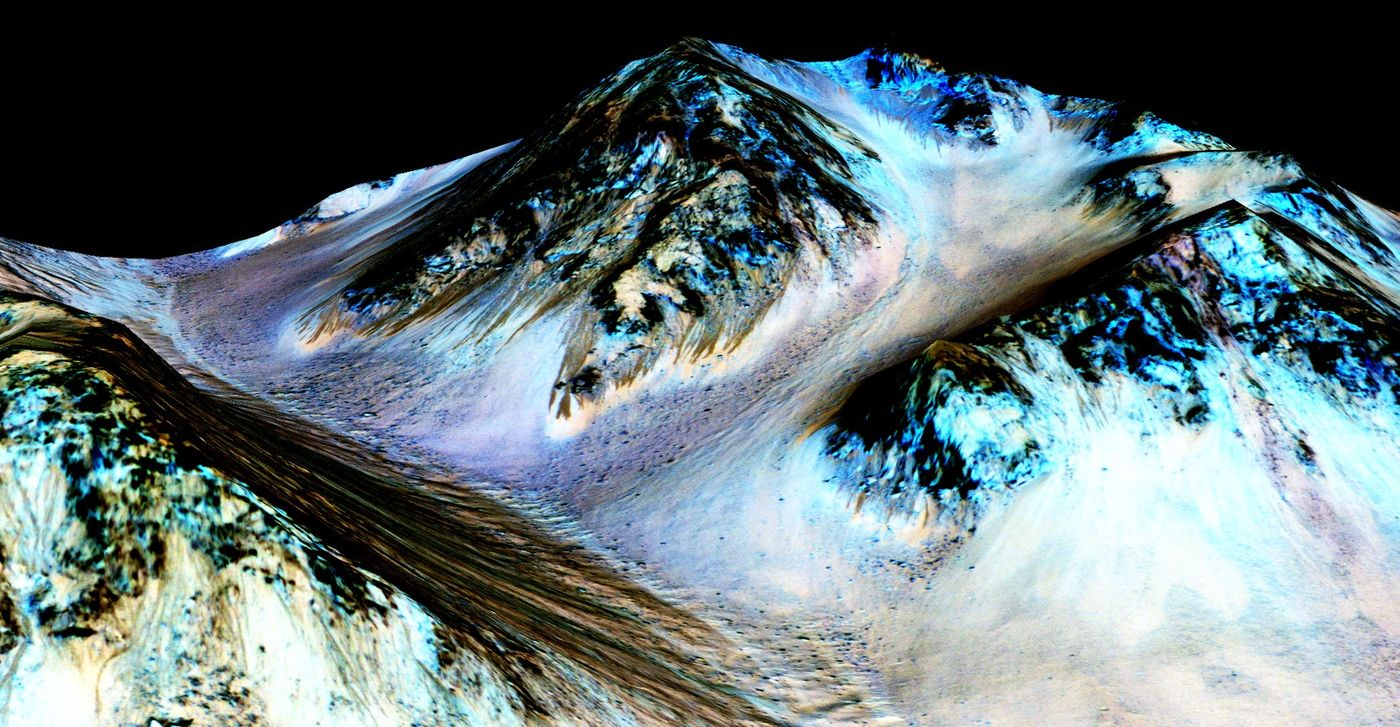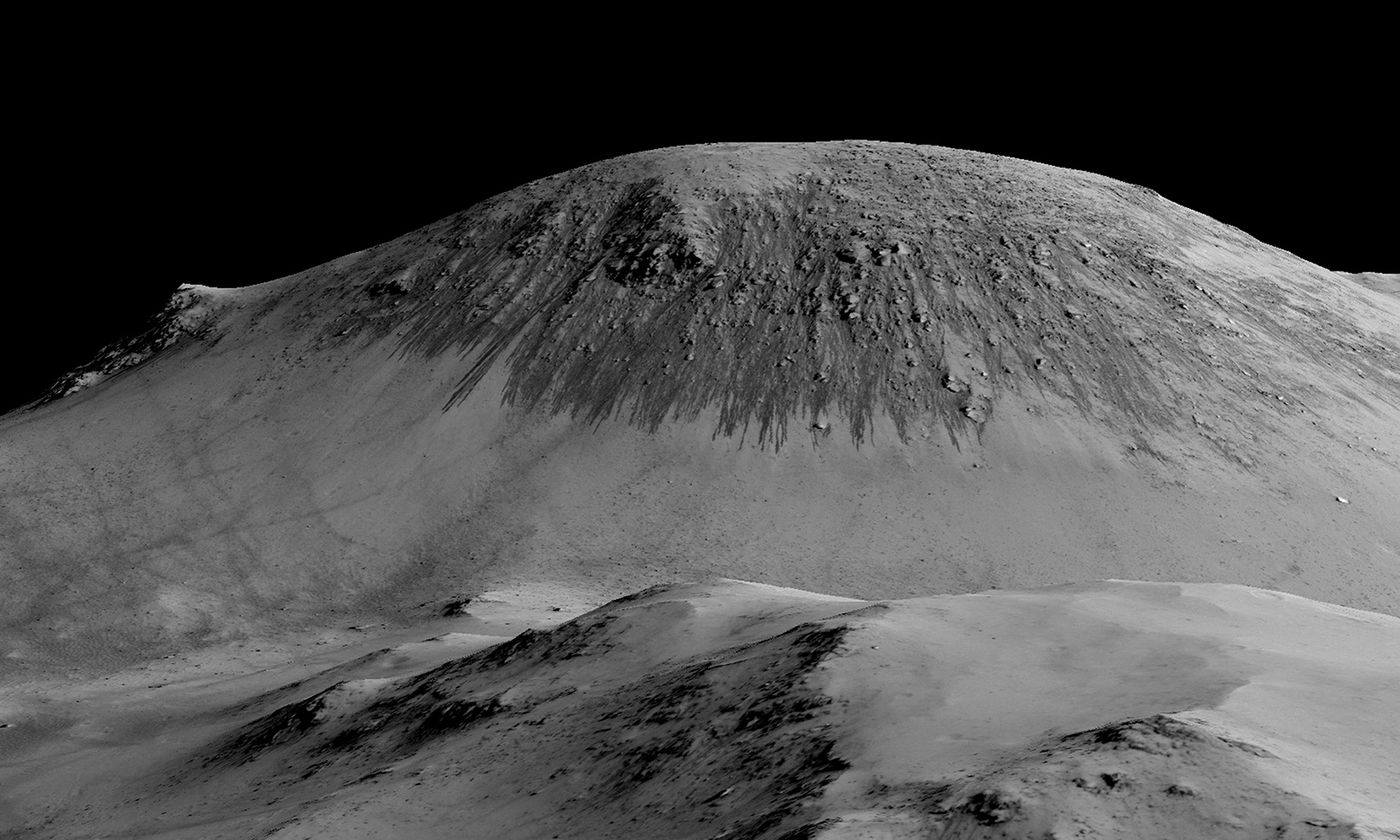Researchers are saying that a discovery of stains from summertime flows down cliffs and crater walls increases the chances of Mars being home to some form of life. The trickling water leaves long, dark stains on the Martian terrain that can reach hundreds of meters downhill in the warmer months before they dry up in the Fall as surface temperatures drop.
NASA has taken images from the Mars orbit which show cliffs and the steep walls of valleys and craters streaking with summertime flows. In the most active spots, these flows combine to form intricate fan-like patterns. As of right now, scientists aren’t sure of the source of the water but it is being speculated that it perhaps rises up from the underground ice or salty aquifers or alternatively condense out of the thin Martian atmosphere.
Michael Meyer, the lead scientists on NASA’s Mars exploration program had the following to say regarding the matter:
There is liquid water today on the surface of Mars. Because of this, we suspect that it is at least possible to have a habitable environment today.
The flowing water could point NASA towards the areas of Mars where they are most likely to find life. Furthermore, they also serve as landing spots for future space missions where water can be collected from a natural supply.
This isn’t the first time that there have been signs of water though entirely. Some of the earliest missions to mars revealed a planet with a watery past. Pictures that were beamed back to Earth in the 1970s showed a surface that was crossed by dried-up rivers and plains that were once submerged underneath large ancient lakes. Furthermore, earlier this year, NASA unveiled that there was evidence of an ocean that might have covered half of the planets northern hemisphere in the past as well.
Occasionally, probes on Mars have also found hints towards the planet still being somewhat wet. Roughly a decade ago, NASA’s Mars Global Surveyor ended up taking pictures of what appeared to be water bursting through a wall and flowing around boulders and other debris. Previously, in 2011, the high-res camera on NASA’s Mars Reconnaissance Orbiter (MRO) also captured what appeared to be little streams of water flowing down crater walls from late spring to early autumn. Scientists at the time didn’t want to assume too much so they ended up naming the flows “recurring slope lineae” which is better known as RSL.
Lujendra Ojha from the Georgia Institute of Technology in Atlanta, along with his colleagues, used a spectrometer on the MRO to look at infrared light reflected off of the steep walls when the dark streaks had just started to appear and then again when they had grown to full length at the end of the summer on Mars. The team described how it found infrared signatures for hydrated salts when the dark flows were present but none before they had grown. These hydrated salts, which are a mix of chlorates and percholorates, are exactly what is required for the presence of water at all four sites that were inspected which consisted of the Hale, Palikir and Horowitz craters along with a large canyon called Coprates Chasma. Alfred McEwen, a planetary geologist at the University of Arizona and senior author on the study had the following to say regarding the matter:
These may be the best places to search for extant life near the surface of Mars. While it would be very important to find evidence of ancient life, it would be difficult to understand the biology. Current life would be much more informative.
An important thing to take note of is that the flows only seem to appear when the surface of the red planet rises above -23C. The water is able to run in such cold conditions because the salt helps to lower the freezing point of the water, allowing it to remain a liquid below the 0C freezing point.

As of right now, researchers seem to be focused on figuring out the source of the water. Speculation points towards porous rocks under the Martian surface that might hold frozen water that melts in the summertime and possibly seeps up to the surface. It could also be that there are highly concentrated saline aquifers that are dotted around the bottom of the surface as saturated volumes of gritty rock. These could end up flowing in certain areas but it doesn’t help to explain the water that seeps down from the top of crater walls. McEwen’s favored possibility regarding the matter is that salts on the Martian surface absorb water from the atmosphere until they have enough to run downhill. This is a process that is referred to as deliquescence and is often seen in the Atacama desert, where the resulting damp patches are known place for microbes to inhabit.
According to John Bridges, a planetary science professor at the University of Leicester, though the study is fascinating, it throws up several concerns for NASA and other space agencies. The flows could potentially be used to find sources of water on the red planet making them the prime spots when it comes to hunting for life and also to land future manned-missions. That being said, we need to make sure we are doing everything possible to avoid contaminating another planets microbes with those from earth – a move which makes the wet areas some of the most difficult to visit.
Everyone’s view on Mars appears to be evolving and it appears that the red planet will remain a hot topic of discussion for quite some time, in both the industry and outside of it.
Source:
NASA (Press Release),
Nature Geoscience,
ScienceMag,
The Guardian










